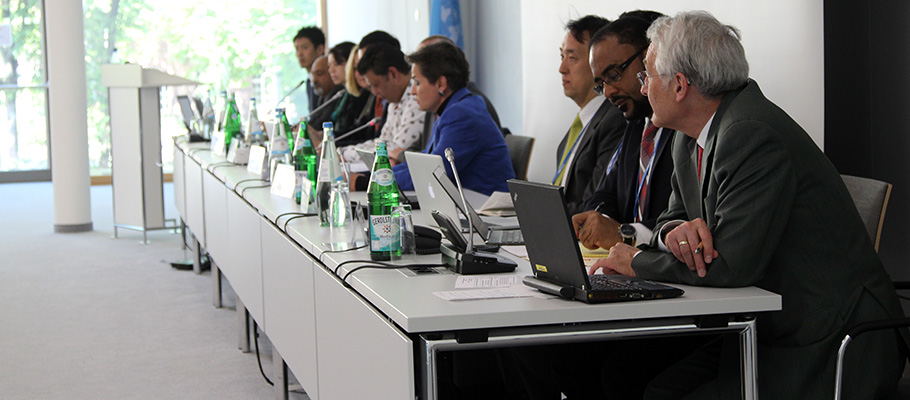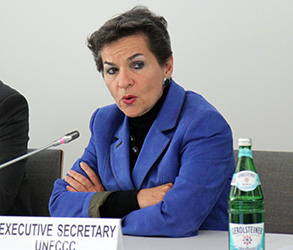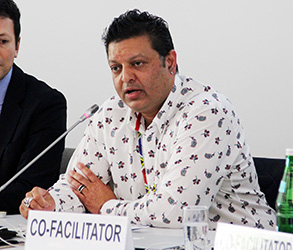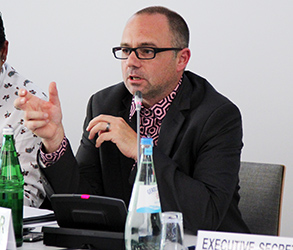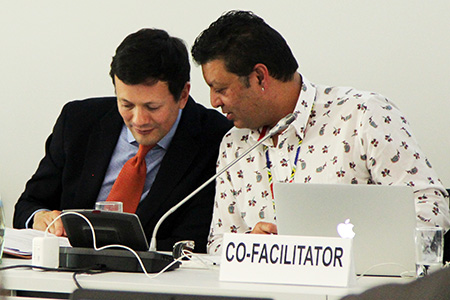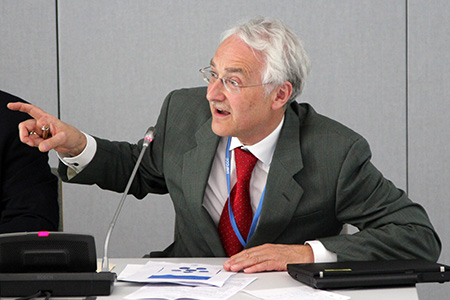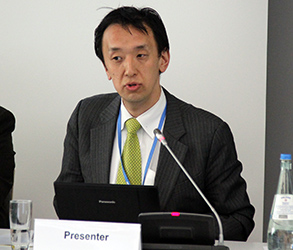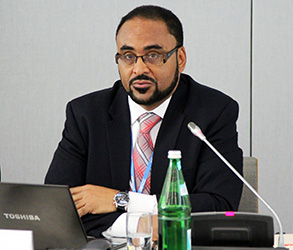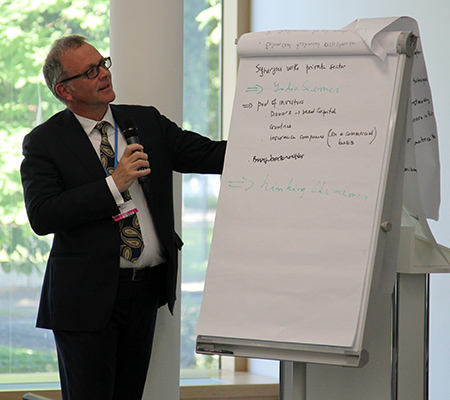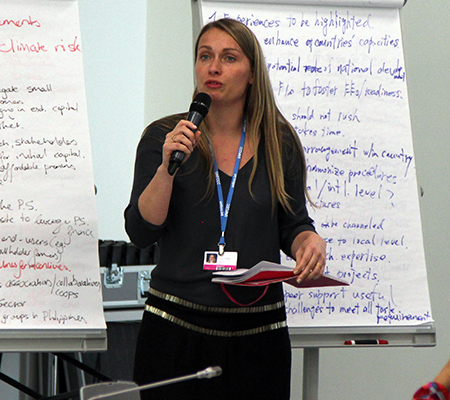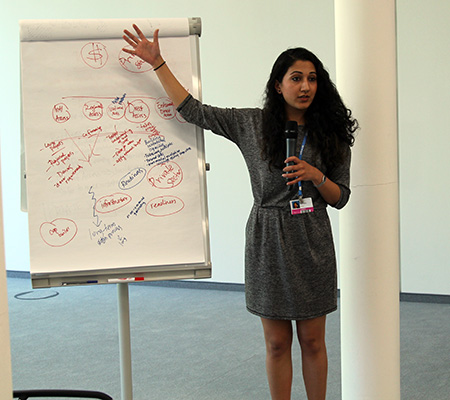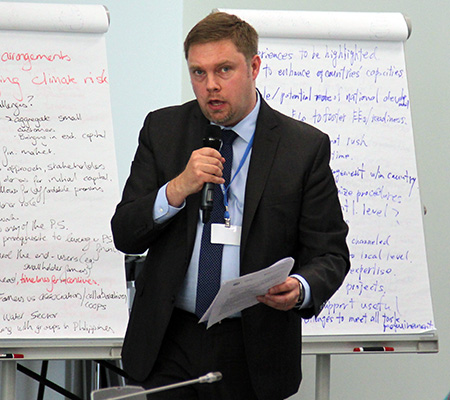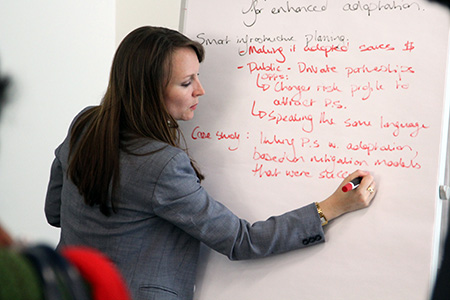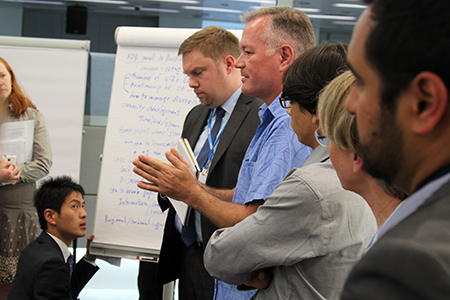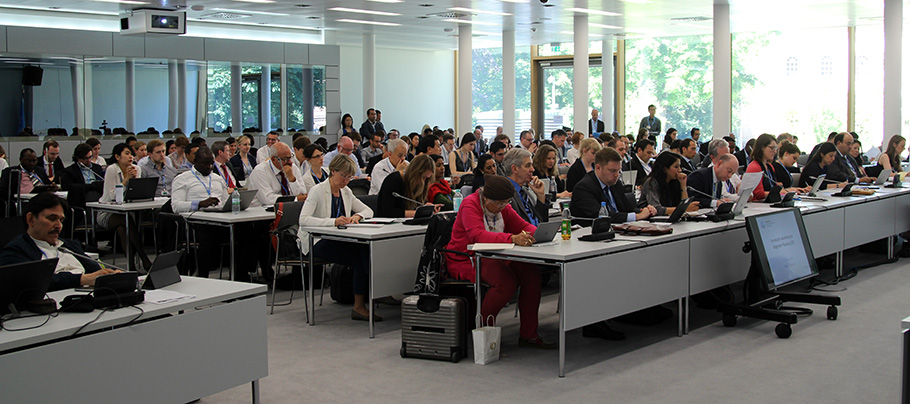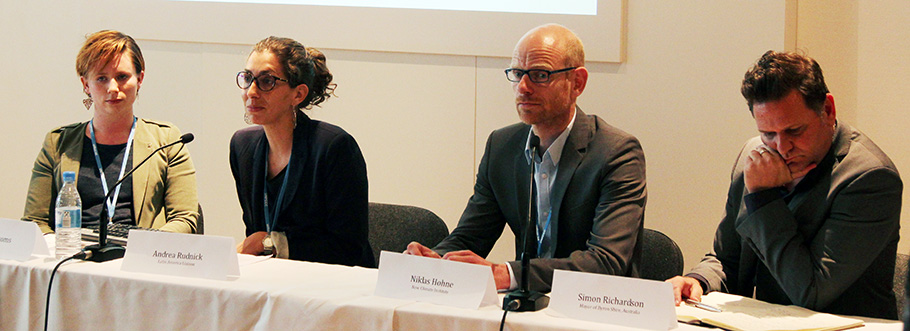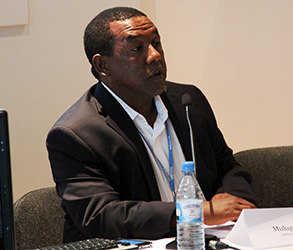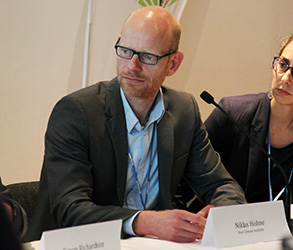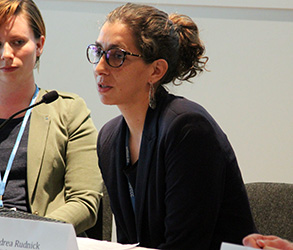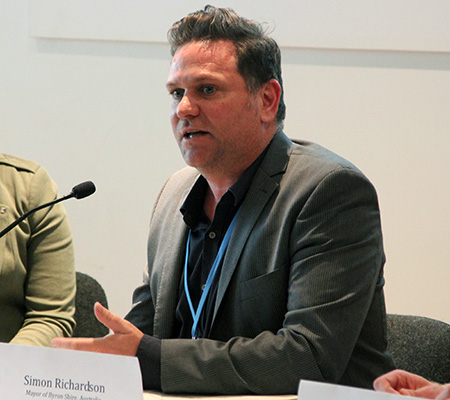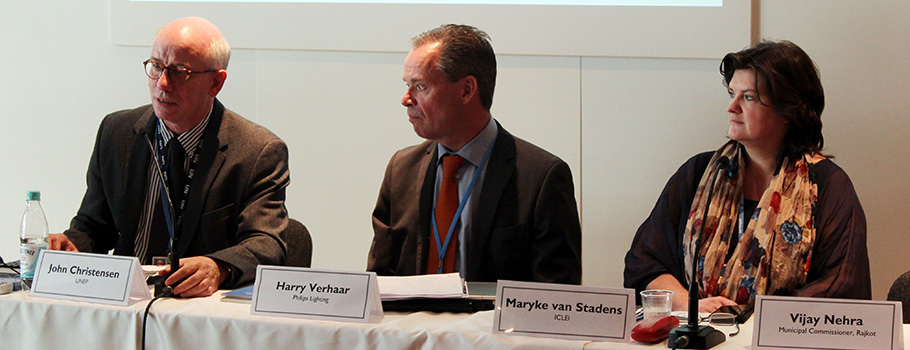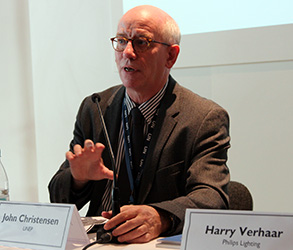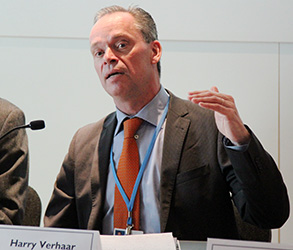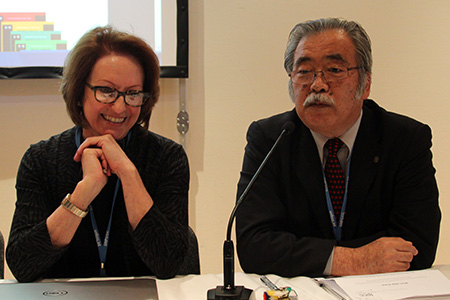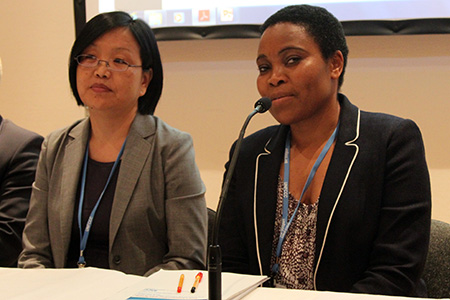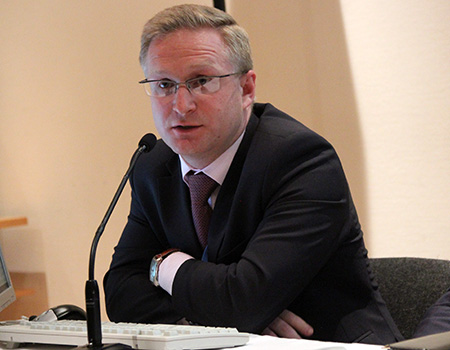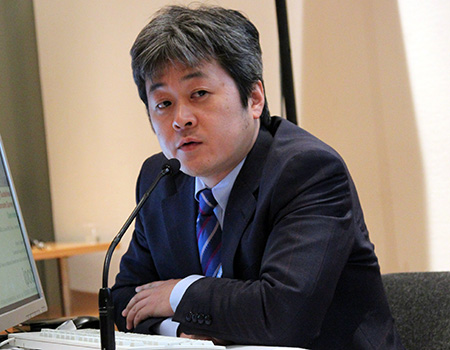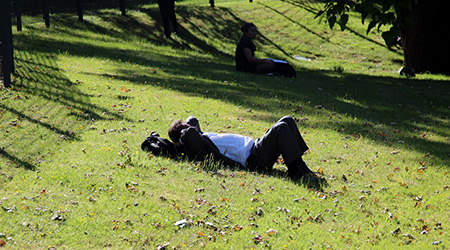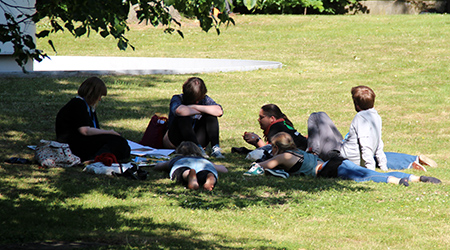Bonn Climate Change Conference - June 2015
1-11 June 2015 | Bonn, Germany
 |
 |
 |
Coverage of Selected Side Events at SBI 42, SBSTA 42 and ADP2-9
Highlights for Thursday, 4 June 2015
Subscribe to our ENBOTS Reports |
||
|
Receive our ENBOTS bulletins and reports by email |
||

| Follow @IISDRS | ||

Loading... |
||
|
Receive emailed updates with the news articles above plus related information and announcements from our CLIMATE-L community mailing list: |
||
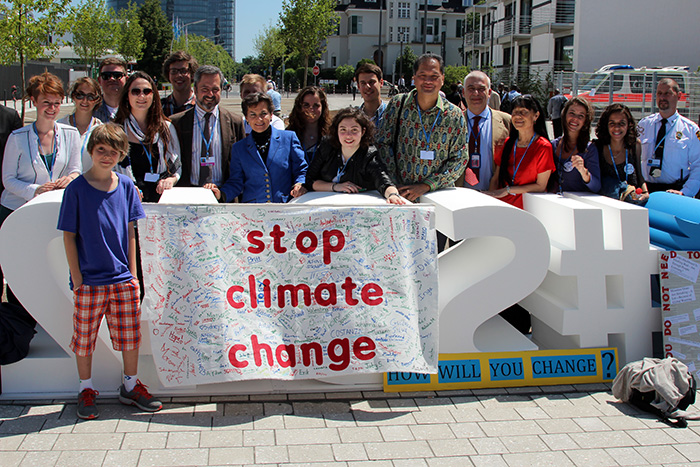
A 10-year old student from the Bonn International School poses in front of his "Stop Climate Change" banner |
||
|
The following side events were covered by ENBOTS on Thursday, 4 June 2015.
|
||
|
IISD Reporting Services, through its Earth Negotiations Bulletin on the Side (ENBOTS) Meeting Coverage, is providing daily digital coverage from selected side events at the Bonn Climate Change Conference - June 2015. | ||
In-session Workshop on Long-term Finance
Organized by the UNFCCC Secretariat
|
|
|
|
|
|
|
|
|
Co-facilitator Zaheer Fakir, South Africa, opened the session and introduced the topic: scaling up adaptation finance. Co-facilitator Dany Drouin, Canada, discussed the context of the workshop and outlined its objectives: exploring opportunities for scaled up and enhanced action on adaptation finance; feeding discussions into the broader process of scaling up climate finance; and generating concrete ideas. Urging the in-session participants not to “fall into simplistic thinking,” Christiana Figueres, Executive Secretary, UNFCCC, said there was a need to think about how to make investments in adaptation attractive and discussed investment in insurance as an example of a profitable activity that could support adaptation. Thematic bodies of the UNFCCC presented on scaling up finance to foster adaptation actions in developing countries. Adaptation Committee member Klaus Radunsky, Austria, discussed, among others, challenges to adaptation finance, including: identifying adaptation versus business-as-usual finance needs; coordination of adaptation finance from different sources at the national level; engagement of the domestic private sector, especially in the LDCs; and oversubscription of the Least Developed Countries Fund (LDCF), Special Climate Change Fund (SCCF) and the Adaptation Fund (AF) during a period of transformation to larger project funding. He also discussed recommendations, including: the need for a long-term strategic framework with National Adaptation Plans (NAPs) as a key tool in this regard; maintaining momentum of National Adaptation Programmes of Action (NAPA) implementation and paying close attention to the link between NAPs and Intended Nationally Determined Contributions (INDCs) and clarifying roles and responsibilities of different operating entities at the international level. Discussing the role of the LDC Expert Group (LEG) in providing technical support and advice on NAPAs and other elements of the LDC work programme, Batu Uprety (Nepal), Chair, LEG, emphasized the importance of a scaled up programmatic and integrated approach to adaptation at the national level to achieve transformational change. He also said there were ongoing discussions with the Green Climate Fund (GCF) to align the strategies between the GCF and the NAPA and NAPs. He expressed concern about the lack of funding for the LDCF, noted that the deceleration in NAPAs would also slow down formulation of NAPs, and urged the Global Environment Facility (GEF) to mobilize funds to support NAPA projects this year. Standing Committee on Finance Co-chair Outi Honkatukia, Finland, provided input on the basis of the ongoing work of the SCF. She highlighted lessons learned from the 2014 Forum on adaptation finance, including: integration of adaptation into development planning, coherence and complementarities among different sources of finance, and the need to support communities to access funds. On the 2014 biennial assessment and overview of climate finance flows, she noted: a convergence among data collectors and aggregators in the operational definition of "climate finance;" the increasing but small share of adaptation finance within climate finance; and a need to further develop impact assessment methods for adaptation. On the fifth review of the financial mechanism, she highlighted the need for: accessibility of funding; country ownership; and complementarity between operating entities of the financial mechanism of the UNFCCC. Introducing the Technology Executive Committee (TEC) as the policy arm of the Technology Mechanism, Kunihiko Shimada, TEC Chair, discussed TEC’s work and inputs to the UNFCCC bodies. On enabling environments for and barriers to adaptation, he stressed the importance of addressing economic, financial and capacity barriers, and pointed to the need to increase availability of and access to finance and build institutional capacity. Noting that research and development (R&D) costs for adaptation technologies were often reflected in project costs given the site specificity of adaptation, he emphasized the need to increase R&D on adaptation and further highlighted the role of close stakeholder collaboration to overcome policy, financial, technology and related challenges. During the plenary session, participants discussed two topics: the role of collaborative arrangements for managing climate risks; and strengthening institutions' capacity to access climate finance. On the role of collaborative arrangements for managing climate risks, Isaac Anthony, Caribbean Climate Risk Insurance Facility (CCRIF), presented on the CCRIF. He identified relevant lessons learned, including: the need for continued dialogue between experts and stakeholders to engage all interests and prevent information asymmetries; donor support, particularly in the initial phase and to market insurance products at reasonable prices; and good governance of the mechanism. Mandy Barnett, South Africa National Biodiversity Institute (SANBI) and Ubaldo Elizondo, Latin American Development Bank (CAF) presented on strengthening institutional capacity to access climate finance. Discussing the role of various access modalities in promoting adaptation, Barnett discussed examples from South Africa including: a direct access experience at Nhlazuka; and the first enhanced direct access modality in two target areas. She identified several lessons for scaling up, including: taking the time to design quality projects and engage stakeholders; supporting capacity development and readiness at all levels; and supporting institutional strengthening and bringing in new players. Discussing CAF’s work on vulnerability mapping, Elizondo highlighted the diagnostic capabilities of such mapping exercises and noted factors that could increase the susceptibility of the population to harm such as poor health, poverty, lack of infrastructure, and conflict. He emphasized the importance of strengthening the capacity of institutions at the local level to identify areas for intervention and noted that financial institutions could design financial products to suit various circumstances once the environment was ready. Sips discussed the role of collaborative action to improve individual schemes and investor pooling, achieve economies of scale, promote affordability, and hasten insurance payouts. He also highlighted the potential opportunity to link individual and regional schemes to achieve greater diversification of risks. De Marez discussed the advantages and disadvantages of financing instruments based on whether they addressed climate risk or broader factors. She noted the need for broad and continuous resilience building strategies in areas of high vulnerability. She also highlighted the UNFCCC’s role in: catalyzing adaptation finance; connecting actors; and engaging in outreach via the Standing Committee on Finance. Ollikainen highlighted numerous capacity-related challenges faced by developing countries in accessing and managing adaptation finance. He said that implementation at the usually bureaucratic sub-national level could be problematic but pointed out that communities were often highly effective once funds were available. Noting the lack of technical expertise at the national level in many countries, he recommended creating a national-level roster of experts and using a network approach to create platforms to access climate finance. Raghav noted her group had identified bottlenecks by linking existing access modalities with various objectives on the ground. She noted that building capacity for direct access was a part of an incremental process and that room for mistakes was vital. She also emphasized the need to think of both readiness and adaptation as long-term processes. The second half of the in-session workshop will take place on June 5, 2015. | ||
|
|
|
|
|
|
|
|
||||
Getting Ready for Zero: An Overview of Who's Working on Zero Carbon Modeling and Tool Kits
Organized by International Network for Sustainable Energy (INFORSE),
Centre for Alternative Technology (CAT), Track 0 and the
Nordic Folkecenter for Renewable Energy
|
|
|
|
|
|
|
This session was moderated by Isabel Bottoms, Track 0. Paul Allen, CAT, presented findings from 27 detailed case studies, showing, inter alia: climate action can be pro-poor, pro-fairness and reduce wasteful energy use; and alternative energies can fulfill cross-sectoral requirements. Gunnar Boye Olesen, INFORSE, discussed processes within Denmark and the European Union to transition to 100% renewable energy, highlighting Denmark’s Fast Transition to Renewable Energy policy, involving local integration of wind and solar energy. Philip James, CAT, presented on Zero Carbon Britain, stressing the need for the UK to reduce its energy demand by 60%. He suggesting means to achieve this goal including switching to electrified heat systems and electricity powered transport technologies. Andrea Rudnick, Latin America Liaison, Mitigation Action Plans and Scenarios (MAPS), described her organization as people-driven, south-south collaboration, and mandated to inform public policy on climate change mitigation. She highlighted difficulties of long-term modeling, including ensuring the validity of the assumptions over time and uncertainties about technology. Simon Richardson, Mayor, Byron Shire, highlighted the Byron Shire Zero Emissions Programme, informing participants that it enjoys citizen support and focuses on promoting zero emissions through addressing waste, revegetation, energy, buildings and public transport. Alexandra Deprez, IDDRI, presented on the Deep Decarbonization Pathways Project which, inter alia, identifies areas of cooperation to achieve low carbon development. She stressed that deep decarbonization will only be possible by scaling up international cooperation, especially the development and transfer of low carbon technologies. Jennifer Morgan, World Resources Institute (WRI), described findings of ACT 2015, noting the strong call for accelerating the pace of change towards zero carbon development. Highlighting that there are different ways to achieve the long term mitigation goal, she stressed that the package agreement in Paris also required long term goals on adaptation and resilience. | ||
|
||||
Accelerating the Implementation of Energy Efficiency Initiatives
Organized by the UN Environment Programme (UNEP) and
the Business Council for Sustainable Energy (BCSE)
|
|
This session was moderated by John Christensen, UNEP DTU (Technical University of Denmark). Noting that the event is part of the Bonn Climate Energy Action Fair, Laura Tierney, BCSE, drew attention to the 2015 Factbook on Sustainable Energy in America published by the BSCE in conjunction with Bloomberg. | ||
|
|
|
|
||||
Technical Assessment of the Intergovernmental Panel on Climate Change (IPCC)
Inventory Guidelines – Results of Questionnaire Survey
Organized by the IPCC
|
|
|
|
|
This event presented results of an international questionnaire survey and the implications of these results for the further development of IPCC inventory guidelines. Taka Hiraishi, Co-chair, IPCC Task Force on National Greenhouse Gas Inventories (TFI), opened the session, noting that without prejudging COP decisions, current consensus suggested that updated guidelines may be needed post-2020. He observed that a refinement process, and not a complete revision, was required and explained that a consultation process was underway to consider the potential refinements that might be needed. Kiyoto Tanabe, IPCC TFI, stated that expert consensus has found that the 2006 guidelines are still technically sound, though some refinements may be required in coming years. Explaining the process of technical assessment being undertaken, he noted that all four sectors were being reviewed, with the aim of identifying high priority areas with global significance and for which data can be feasibly obtained. He explained the assessment consultation process would involve the results of the online questionnaire survey and two expert meetings taking place in June and July 2015. Noting that the online survey received 987 comments from 243 experts, he called on speakers to present the sectoral findings. Pavel Shermanau, IPCC TFI, presented results of the survey relating to the energy sector, noting that 11 high priority issues had been identified, with comments suggesting, inter alia: reconsidering and updating the default oxidation factors for fuels; and updating non-energy use of fuels. In the industrial sector, he noted seven priority issues highlighted in the mineral, chemical and metal industries, among others. Baasansuren Jamsranjav, IPCC TFI, presented research from the waste sector, in which 11 priority issues were identified, including, inter alia: updating the municipal solid waste generation rate; and updating default emission factors for emissions from biological treatment and incineration of waste. Presenting findings from the agriculture, forestry, and other land use (AFOLU) sector, Jamsranjav and Sekai Ngarize, IPCC, noted suggestions received for areas including: livestock; land; and aggregate sources and non-CO2 emissions on land. They highlighted 32 overall high priority areas in this sector, including, among others: new models for enteric fermentation; refinement of parameters for manure management; and issues relating to the further development of methods to estimate emissions and removals, such as remote sensing in forests. Participants then considered, inter alia: the speed and process of improving IPCC inventory guidelines; IPCC’s emission factor database; and the potential need to improve technological guidance sources as well as printed guidelines. | ||
|
||||
|
|
|
The Earth Negotiations Bulletin on the side (ENBOTS) © <enb@iisd.org> is a special publication of the International Institute for Sustainable Development (IISD). This issue has been written by Rishikesh Ram Bhandary, Tallash Kantai and Gillian Nelson, Ph.D. The Digital Editor is Mike Muzurakis. The Editor is Dan Birchall <dan@iisd.org>. The Director of IISD Reporting Services is Langston James “Kimo” Goree VI <kimo@iisd.org>. Specific funding for coverage of side events through ENBOTS has been provided by the Kingdom of Saudi Arabia. The opinions expressed in ENBOTS are those of the authors and do not necessarily reflect the views of IISD and funders. Excerpts from ENBOTS may be used in non-commercial publications only with appropriate academic citation. For permission to use this material in commercial publications, contact the Director of IISD Reporting Services at <kimo@iisd.org>. Electronic versions of issues of ENBOTS from the Bonn Climate Change Conference - June 2015 can be found on the Linkages website at http://enb.iisd.org/climate/sb42/enbots/. The ENBOTS Team at the Bonn Climate Change Conference - June 2015 can be contacted by e-mail at <tallash@iisd.org>. | ||
has been provided by the Kingdom of Saudi Arabia and the European Union


IISD Reporting Services is grateful to the many donors of the Earth Negotiations Bulletin (ENB) and recognizes the following as core contributors to the ENB: the European Union, the Finnish Ministry for Foreign Affairs, the German Federal Ministry for the Environment, Nature Conservation, Building and Nuclear Safety (BMUB), the International Development Research Centre (IDRC), the Japanese Ministry of Environment (through the Institute for Global Environmental Strategies - IGES), the New Zealand Ministry of Foreign Affairs and Trade, the Kingdom of Saudi Arabia, SWAN International, Government of Switzerland (the Swiss Federal Office for the Environment (FOEN), the Swiss Agency for Development Cooperation (SDC), and the United Nations Environment Programme (UNEP). Funding for translation of the Bulletin into French is provided by the Government of France, the Wallonia, Québec, and the International Organization of La Francophonie/Institute for Sustainable Development of La Francophonie (IOF/IFDD).




